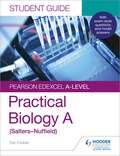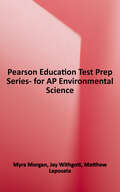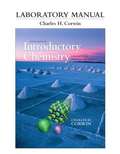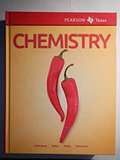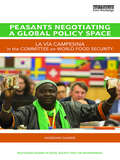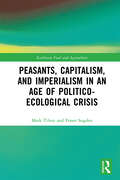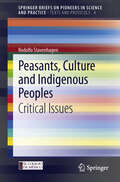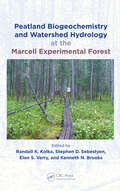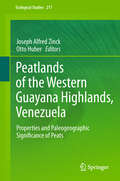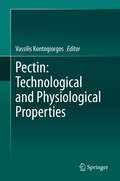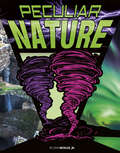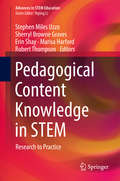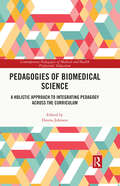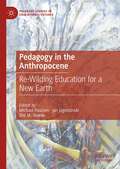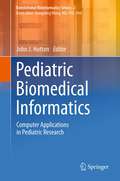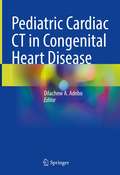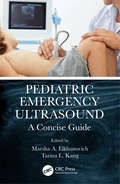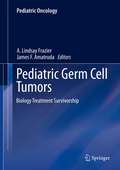- Table View
- List View
Pearson Edexcel A-level Biology (Salters-Nuffield) Student Guide: Practical Biology
by Dan FoulderGet to grips with the core practicals and develop the skills students need to succeed with an assessment-driven approach, combining clear summaries of practical work that reinforce understanding, with sample questions and answers to improve exam technique. - Easily identify what students need to know with a concise summary of the required practical work examined in the A-level specifications. - Consolidate understanding of practical work, methodology, mathematical and other skills out of the laboratory with exam tips and knowledge check questions, with answers in the back of the book. - Improve exam technique with sample answers, examiner's tips and exam-style questions. - Provide extra support with coverage of methodologies and generic practical skills not focused on in the textbooks.
Pearson Edexcel A-level Biology (Salters-Nuffield) Student Guide: Practical Biology
by Dan FoulderGet to grips with the core practicals and develop the skills students need to succeed with an assessment-driven approach, combining clear summaries of practical work that reinforce understanding, with sample questions and answers to improve exam technique. - Easily identify what students need to know with a concise summary of the required practical work examined in the A-level specifications. - Consolidate understanding of practical work, methodology, mathematical and other skills out of the laboratory with exam tips and knowledge check questions, with answers in the back of the book. - Improve exam technique with sample answers, examiner's tips and exam-style questions. - Provide extra support with coverage of methodologies and generic practical skills not focused on in the textbooks.
Pearson Education Test Prep Series for AP Environmental Science
by Myra MorganOf all of the AP science courses, AP Environmental Science is unique in that it focuses primarily on the relevant and pressing problems that face our species and the planet. It is an applied science that focuses on problem-solving, understanding environmental issues by emphasizing critical thinking, and encouraging you to propose possible solutions by immersing yourself in the science behind the issues. Laboratory and field investigations also form an essential component of the course, as these experiences afford critical insights into how science is practiced, how environmental problems are studied, and how humans worldwide are affecting their environment.
Pearson Laboratory Manual for Introductory Chemistry: Concepts And Critical Thinking, Sixth Edition
by Charles H. CorwinEmphasizing environmental considerations, Corwin's lab manual offers a proven format of a prelaboratory assignment, a stepwise procedure, and a postlaboratory assignment. The Sixth Edition features a completely updated interior design, new environmental icons denoting "green" features, updated prelabs, and much more.
Pearson Physical Science: Concepts in Action with Earth and Space Science
by Michael Wysession David Frank Sophia YancopoulosTextbook on physical science.
Pearson Physics
by James VaikerThe 2014 edition of the popular physics textbook series. Every class contains a unique and diverse group of students. Pearson Physics supports each student's unique learning style, offering all students a path to success.
Pearson Texas Chemistry
by Edward Waterman Dennis Staley Antony Wilbraham Dr Michael MattaPearson Chemistry was customized especially for Texas! Covering 100% of the Texas Essential Knowledge and Skills for Chemistry, this program was built on feedback from Texas educators. Pearson Texas Chemistry focuses on what is important to Texas teachers and students, creating a truly accessible program for all students and an engaging classroom experience. Pearson would like to extend a special thank you to all of the teachers from across the state of Texas who helped guide the development of this program.
Peas and Beans: A Color Handbook (Crop Production Science in Horticulture)
by Anthony J BiddleThis practical book provides an accessible overview of all aspects of pea and bean production, including botany and physiology, breeding, agronomy, weed management, pests and diseases, harvesting, nutritional value and uses. It also reflects on the constraints and opportunities in the future for peas and beans, exploring their role in food sustainability and crop rotation, and various factors affecting supply and demand such as climate change and breeding technologies. Peas and beans are crops of economic, social and agronomic importance and this volume provides the specialist knowledge needed to ensure good quality standards are met. It includes: · coverage of the main types of peas and beans grown on a significant scale or commercially produced in large area farming; · key information relating to the role of peas and beans in biological nitrogen fixation; · extensive coverage from the technology of cultivation to postharvest industry; and · high-quality photos, presented in full colour throughout. Authored by a recognized authority with extensive experience in applied research, this book is an ideal resource for practical agronomists, advisors and producers, extension workers, horticulture students and all those involved in the production of peas and beans.
Peasants Negotiating a Global Policy Space: La Vía Campesina in the Committee on World Food Security (Routledge Studies in Food, Society and the Environment)
by Ingeborg GaardeBeing the public voice of over 180 member organisations across nearly 90 countries, La Vía Campesina, the global peasant movement, has planted itself firmly on the international scene. This book explores the internationalisation of the movement, with a specific focus on the engagement of peasants in the processes of the Committee on World Food Security (CFS). Since the reform of the CFS in 2009, civil society actors engage in the policy processes of this UN Committee from a self-designed and autonomous global Civil Society Mechanism. The author sheds light on the strategies, tensions, debates, and reconfigurations arising from rural actors moving between every day struggles in the fields and those of the UN arena. Whereas most theories in the dominant literature on social movements expect them to either disappear or institutionalise in a predetermined pattern, the book presents empirical evidence that La Vía Campesina is building a much more sophisticated model. The direct participation of representatives of peasant organisations in the CFS is highlighted as a pioneering example of building a more complex, inclusive and democratic foundation for global policy-making. Foreword by Olivier De Schutter, United Nations Special Rapporteur on the Right to Food (2008-2014).
Peasants, Capitalism, and Imperialism in an Age of Politico-Ecological Crisis (Earthscan Food and Agriculture)
by Mark Tilzey Fraser SugdenThis book utilises a new theoretical approach to understand the dynamics of the peasantry, and peasant resistance, in relation to capitalism, state, class, and imperialism in the global South. In this companion volume to Peasants, Capitalism, and the Work of Eric R. Wolf, the authors further develop their thinking on agrarian transitions to capitalism, the development of imperialism, and the place of the peasantry in these dynamics, with special reference to the global South in an era of politico-ecological crisis. Focusing on the political role of the peasantry in contested transitions to capitalism and to modes of production outside of, and beyond, capitalism, the book contends that an understanding of these dynamics requires an analysis of class struggle and of the resources, material and discursive, that different classes can bring to bear on this struggle. The book focuses on the rise of capitalism in the global South within the context of imperial subordination to the global North, and the place of the peasantry in shaping and resisting these dynamics. The book presents case studies of contested transitions to agrarian capitalism in Bolivia, Ecuador, Guatemala, Mexico, Peru, and South Asia. It also examines the case of transition to a post-capitalist mode of production in Cuba. The book concludes with an assessment of the nature of capitalism and imperialism within the context of the contemporary politico-ecological crisis, and the potential role of the peasantry as agent of emancipatory change towards social and environmental sustainability. This book will be of great interest to students and researchers in the areas of peasant studies, rural politics, agrarian studies, development, and political ecology.
Peasants, Culture and Indigenous Peoples
by Rodolfo StavenhagenThis last volume in a trilogy published on the occasion of the 80th birthday of Rodolfo Stavenhagen, professor emeritus of El Colegio de Mexico, includes eight essays on Peasants, Culture and Indigenous Peoples: Critical Issues; Basic Needs, Peasants and the Strategy for Rural Development (1976); Cultural Rights: a Social Science Perspective (1998); The Structure of Injustice: Poverty, Marginality, Exclusion and Human Rights (2000); What Kind of Yarn? From Color Line to Multicolored Hammock: Reflections on Racism and Public Policy (2001); The United Nations Special Rapporteur on the Rights of Indigenous Peoples (2012); A Report on the Human Rights Situation of Indigenous Peoples in Asia (2007); Report on the Impact of Megaprojects on the Rights of Indigenous Peoples (2003); and Study Regarding the Best Practices to Implement the Recommendations of the Special Rapporteur (2007). These texts address human rights issues, especially those that arose when Stavenhagen was servinged as United Nations special rapporteur on the rights of indigenous peoples.
Peatland Biogeochemistry and Watershed Hydrology at the Marcell Experimental Forest
by Kenneth N. Brooks Randall K. Kolka Stephen D. Sebestyen Elon S. VerryThe Marcell Experimental Forest (MEF) in Minnesota serves as a living laboratory and provides scientists with a fundamental understanding of peatland hydrology, acid rain impacts, nutrient and carbon cycling, trace gas emissions, and controls on mercury transport in boreal watersheds. Its important role in scientific research continues to grow as t
Peatlands of the Western Guayana Highlands, Venezuela
by Joseph Alfred Zinck Otto HuberThe Guayana Highlands in northeastern tropical America, rising from lowland rain forests and savannas up to 3000 m elevation, are characterized by ancient tablelands called tepuis. The peatlands that developed on the tepuis constitute unique and fascinating ecosystems and are the focus of this volume, which starts with an overview of tropical and subtropical peats, followed by an introduction to the geo-ecological features of the Guayana region as a whole, with special emphasis on the diversity of the vegetation cover from lowlands to uplands to highlands. The core subject centers on the properties and dating of the peat deposits and the interpretation of the chronological record in terms of past environmental changes. The well illustrated book will appeal to a broad range of scientists interested in tropical highland peats, including quaternarists, soil scientists, geomorphologists, geographers, geologists, ecologists, botanists, hydrologists, conservationists, and land use planners.
Pectin: Technological and Physiological Properties
by Vassilis KontogiorgosThis text presents the technological and physiological properties of pectin in an educational approach that encompasses all of the essential information a researcher needs to fully understand their function and use in foods. Utilizing basic information on pectin as well as recent technological advances, this book is designed to be the primary resource for individuals seeking out an up to date reference work covering all the necessary informational and functional aspects of pectin. Pectin: technological and physiological properties is the first book to fully focus on the introductory concepts on pectin. Individual chapters cover localization and function, the structural aspects of pectin, pectinases, isolation and characterization and recovery from agricultural wastes. Important current advances such as emulsions, films, digestion, metabolism and bioactive properties are also focused on. With its combination of vital basic information and technological advances, this book presents full and up to date coverage on this pectin and its many forms and uses in foods.
Peculiar Nature (Anything But Ordinary)
by John Micklos Jr.The natural world can be a beautiful and awesome place. But sometimes things happen naturally that are quite peculiar. Have you heard of Blood Falls in Antarctica? Ice cold water flows bright red out of a glacier. Did you know that Death Valley National Park in California has boulders that mysteriously slide across the desert? Learn the details of these mysteries and other peculiar natural phenomena.
Peculiar Primates: Fun Facts About These Curious Creatures
by Debra Kempf ShumakerFrom flossing and howling, to building nests and thumping chests, this delightful follow up to Freaky, Funky Fish explores the amazing things primates do. All primates climb and breathe in air. They have big brains and hands and hair. But. . . some live alone, some live in groups. One primate has a nose that droops. Peculiar Primates is an adorable picture book with a scientific—and child-friendly—underpinning. With examples of different primates for each description, as well as extensive backmatter explaining the fascinating science behind their behaviors, this bizarre book captures the wonders of our ecosystem.
Pedagogical Content Knowledge in STEM: Research to Practice (Advances in STEM Education)
by Robert Thompson Erin Shay Stephen Miles Uzzo Sherryl Browne Graves Marisa HarfordThis volume represents both recent research in pedagogical content knowledge (PCK) in science, technology, engineering and math (STEM), as well as emerging innovations in how PCK is applied in practice. The notion of “research to practice” is critical to validating how effectively PCK works within the clinic and how it can be used to improve STEM learning. As the need for more effective educational approaches in STEM grows, the importance of developing, identifying, and validating effective practices and practitioner competencies are needed. This book covers a wide range of topics in PCK in different school levels (middle school, college teacher training, teacher professional development), and different environments (museums, rural). The contributors believe that vital to successful STEM education practice is recognition that STEM domains require both specialized domain knowledge as well as specialized pedagogical approaches. The authors of this work were chosen because of their extensive fieldwork in PCK research and practice, making this volume valuable to furthering how PCK is used to enlighten the understanding of learning, as well as providing practical instruction. This text helps STEM practitioners, researchers, and decision-makers further their interest in more effective STEM education practice, and raises new questions about STEM learning.
Pedagogies of Biomedical Science: A Holistic Approach to Integrating Pedagogy Across the Curriculum (Contemporary Pedagogies of Medical and Health Professions’ Education)
by Donna JohnsonThis book confronts the continually evolving nature of biomedical science education by providing a robust account of learning pedagogies and best practice for scholars and researchers in the field.Rather than considering subdisciplines of biomedical science education separately, the volume takes a holistic approach and considers the complexities of teaching biomedical science as a whole, providing a nuanced overview of how a particular practice fits in such a course overall, as well as providing support for development within the reader’s own subdiscipline. Ultimately, this holistic approach allows for expansive discussion of relevant pedagogical approaches that will directly inform innovations in the contemporary teaching of biomedical science education.Novel in approach and underpinned by the latest in research innovations, this book will appeal to scholars, researchers and postgraduate students in the fields of medical education, higher education, and curriculum studies. Policy makers involved with health education and promotion as well as educational research will also benefit from the volume.
Pedagogy in the Anthropocene: Re-Wilding Education for a New Earth (Palgrave Studies in Educational Futures)
by Jan Jagodzinski Michael Paulsen Shé M. HawkeThis book explores new pedagogical challenges and potentials of the Anthropocene era. The authors argue that this new epoch, with an unstable climate, new kinds of globally spreading viruses, and new knowledges, calls for a new way of educating and an alertness to new philosophies of education and pedagogical imaginations, thoughts, and practices. Addressing the linkages between the Anthropocene and Pedagogy across a broad pedagogical spectrum that is both formal and informal, the editors and their contributors emphasize a re-imagining of education that serves to deepen our understanding of the capacities and values of life.
Pedagogy of Entanglement: A Response to the Complex Societal Challenges that Permeate our Lives (Sustainable Development Goals Series)
by Koen Rens WesselsIn this hyperconnected, dynamic world we live in, permeated by profound challenges and transformations, the awareness of complexity is unequivocally on the rise. This monograph argues that it is high time that our educational institutions and pedagogical approaches come to mirror this growing awareness, to assist and inspire humanity to embrace complexity, to learn to move within it with increasing sensitivity and wisdom. Doing so is necessary, for if there is one thing that the years behind us bear witness of, it is that the tendency and attempt to simplify, separate, control, and indeed exploit has – as the dark side of the advancements of modern life – brought upon us unprecedented ecological and humanitarian crises. Schools, notably, are not closed spaces separated from society but open places within society, and as such they are inevitably complicit in the (re)shaping of our shared world. This book, therefore, proposes an ambitious pedagogical agenda. Specifically, it explores the relational ontological premise of entanglement in the context of pedagogical theory, raising the question of how, as teachers, we might meaningfully and responsibly engage with the myriad ways in which students are simultaneously shaped-by and shapers-of contemporary societal challenges. In close collaboration with twelve teachers as co-researchers, the book offers six ''helpful perspectives'' for teachers seeking to embrace such complexity in their own practices, referred to as: (1) entanglement-orientedness, (2) entanglement-awareness, (3) hopeful action, (4) inquiry within entangled phenomena, (5) practicing perceptiveness, and (6) practicing integrity.
Pediatric Biomedical Informatics
by John J. HuttonAdvances in the biomedical sciences, especially genomics, proteomics, and metabolomics, taken together with the expanding use of electronic health records, are radically changing the IT infrastructure and software applications needed to support the transfer of knowledge from bench to bedside. Pediatric Biomedical Informatics: Computer Applications in Pediatric Research describes the core resources in informatics necessary to support biomedical research programs and how these can best be integrated with hospital systems to receive clinical information that is necessary to conduct translational research.The focus is on the authors' recent practical experiences in establishing an informatics infrastructure in a large research-intensive children's hospital. This book is intended for translational researchers and informaticians in pediatrics, but can also serve as a guide to all institutions facing the challenges of developing and strengthening informatics support for biomedical research. The first section of the book discusses important technical challenges underlying computer-based pediatric research, while subsequent sections discuss informatics applications that support biobanking and a broad range of research programs. Pediatric Biomedical Informatics provides practical insights into the design, implementation, and utilization of informatics infrastructures to optimize care and research to benefit children. Dr. John Hutton is the Vice President and Director of Biomedical Informatics at Cincinnati Children's Hospital Medical Center, Cincinnati, OH, USA. He is also Professor of Pediatrics and Associate Dean for Information Services at the University of Cincinnati College of Medicine.
Pediatric Cardiac CT in Congenital Heart Disease
by Dilachew A. AdeboThis book serves as a comprehensive guide to pediatric cardiac computed tomography (CT), particularly for patients with congenital heart disease. Congenital heart disease (CHD) is the leading cause of congenital abnormalities (8/1000 of live births). Over the past two decades, the diagnostic medical approach has significantly changed with a considerable increase in the number of CT studies in pediatric patients. Preoperative surgical or interventional planning for children with CHD remains crucial and challenging, but despite this and the advancement in the development of new CT techniques and radiation dose reduction methods, there are limited books addressing pediatric cardiac CT.This work fills that gap by offering a complete look at the techniques and clinical utilization for pediatric cardiac CT with liberal use of images. The text begins with overarching themes of pediatric cardiac CT, like its advantages and techniques, and moves into covering different areas of the heart and possible presentations, like atrioventricular connections and cardiac tumors. Each chapter begins with a short introduction section followed by preoperative and postoperative cardiac CT imaging, management approach, and short-term and long-term outcomes. This book also describes the novel technologies being used for three-dimensional modelling and three-dimensional printing in the surgical preparation of patients with complex congenital heart disease. This book is the first to address pediatric cardiac CT image fusion to fluoroscopy to guide cardiac catheterization in patients with complex congenital heart disease. Radiation dose reduction during cardiac catheterization is also an important part of diagnostic and interventional cardiac catheterization that is covered in detail. The book concludes with an overarching look of the role cardiac CT plays in the pre- and post-operative evaluation of congenital heart disease in children.This book is an ideal guide for pediatric radiologists, pediatric cardiologists, pediatric cardiothoracic surgeons, related trainees, and any physician interested in advanced cardiac imaging.
Pediatric Emergency Ultrasound: A Concise Guide
by Marsha A. Elkhunovich Tarina L. Kang Courtney Brennan Kathryn Pade Rashida Campwala Jessica Rankin Kristin BeronaThis concise, portable manual provides practitioners and future practitioners with a basic guide to pediatric emergency ultrasound, enabling them to learn the fundamentals of bedside ultrasound and use these to refresh their skills prior to, or when, performing it on a patient.
Pediatric Germ Cell Tumors
by A. Lindsay Frazier James F. AmatrudaGerm cell tumors are relatively rare compared with other malignancies, and compilations of knowledge that encompass the entire spectrum of the disease are lacking. This textbook, written by the foremost authorities in the field, rectifies the situation by discussing in depth a broad range of topics, including biology, epidemiology, pathology, treatment, and late effects. Bearing in mind that germ cell tumors are most prevalent in the adolescent and young adult age group, causes of disease and treatment approaches in pediatric and adult patients are compared and contrasted. By spanning the entire life course, from prenatal origins of disease through to treatment in adults and late effects of treatment, the editors have produced a book that will be of interest to both pediatric and adult oncologists.
